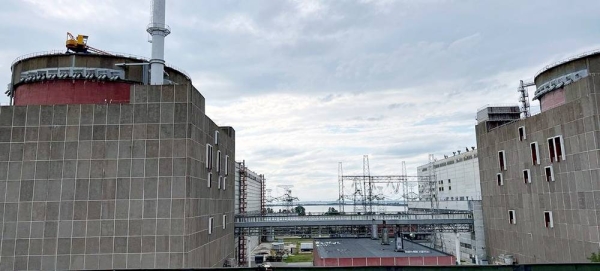
Further damage to the embattled Zaporizhzhya Nuclear Power Plant in Ukraine “cannot” be allowed to happen, the head of the International Atomic Energy Agency (IAEA) has said.
Director General Rafael Mariano Grossi was speaking on Thursday after he and IAEA experts visited Europe’s largest nuclear plant, which has seen repeated shelling in recent weeks, sparking fears of a catastrophe.
“It"s obvious that the plant, and the physical integrity of the plant has been violated, several times. [Whether] by chance [or deliberately], we don"t have the elements to assess that. But this is a reality that we have to recognize, and this is something that cannot continue to happen,” he told journalists.
“Wherever you stay, wherever you stand, whatever you think about this war, this is something that cannot happen, and this is why we"re trying to put in place certain mechanisms and the presence of our people there, to try to be in a better place.”
The Zaporizhzhia plant houses six of the 15 nuclear reactors in Ukraine. It has been occupied by Russian forces since the early weeks of the war in Ukraine, now in its seventh month.
Both sides have accused the other of shelling the plant.
Maintaining a presence
An IAEA expert mission finally arrived there on Thursday, following months of diplomatic negotiations.
In a video posted on his official Twitter account that day, Grossi reported that the experts had completed an initial tour of the plant, though there is still more to do.
“My team is staying on,” he said, adding, “most importantly, we are establishing a continued presence from the IAEA here.”
The 14-member mission deployed from Vienna on Monday in efforts towards ensuring nuclear safety and security at the plant, undertaking vital safeguard activities, and assessing the working conditions of the Ukrainian staff there.
Renewed shelling last week hit the area of the plant’s two so-called special buildings, located about 100 meters from the reactor buildings, as well as an overpass area.
‘Code red’
In a press conference he held on Friday night, immediately upon his return to Vienna, home to the IAEA, Grossi said that color coding the degree of danger at the plant, meant that it was “a big code red”.
“Why is it a big red? It"s because we have been seeing military activity around the plant and I was able to see, myself and my team, impact holes/markings on buildings, of shelling, so which means that the physical integrity of the facility has been violated not once, but several times.”
When it comes to the safety and security system, “which is fully functional, we assess it with a yellow because some of them or most of them are working, and have working been relatively well, but there have been interruptions,” he told reporters at Vienna airport.
"Modus vivendi"
As for operating conditions, where Ukrainians and Russians are sharing the running of the plant, “we don"t put it fully red for one reason, and it is that the plant continues to operate and there is a professional ‘modus vivendi’...they work together and the plant, as it is obvious because it has been operating — two units, as of today, are still operating, including unit No. 5, which was crammed a couple of days ago and now it"s back in operation.”
He said Zaporizhzhya, the biggest nuclear power plant in Europe, also needed to be viewed as a “big industrial facility as at any industrial facility, you need spare parts. There are things that need to be replaced and so on and so forth. Given the anomalous situation of the war, it is obvious that logistical chains are interrupted.”
WHO donates ambulances to Ukraine
Meanwhile, the World Health Organization (WHO) has delivered 11 first aid ambulances to Ukraine amid ongoing attacks against healthcare in the country, the UN agency reported on Friday.
The vehicles will be handed over to the Emergency Medical Service Department in Lviv, then distributed throughout Ukraine.
The donations were made possible through support from the UN Central Emergency Response Fund (CERF), which ensures that urgently needed humanitarian assistance reaches people caught up in crises.
Timely transport saves lives
“These ambulances will save lives and go a step further in ensuring that timely access to emergency care during the war is strengthened and maintained,” said Dr. Jarno Habicht, WHO Representative in Ukraine.
He was speaking at a handover ceremony alongside Ukraine’s Health Minister, Dr. Viktor Liashko, who emphasized that international support is a powerful tool in sustaining the country’s medical system during wartime.
“Emergency healthcare workers are the first ones to arrive at the scene of an accident and do everything they can to save people’s lives,” he said.
“Thanks to modern ambulances, healthcare workers not only provide timely transport for people who are injured or in critical condition from the accident scene to a medical facility, but also stabilize their condition during transport.”
WHO and partners have donated more than 30 ambulances to Ukraine"s Ministry of Health since the war began on Feb. 24, with more deliveries expected later in the year.
The agency has also delivered more than 1,300 metric tons of life-saving medical supplies to the country, including power generators, oxygen supplies for medical facilities, and medicines to help treat noncommunicable diseases.
Winter support for vulnerable groups
Also on Friday: A UN Humanitarian Fund has allocated $70 million to kick-start winter assistance and address the needs of people with disabilities, older persons and vulnerable women in Ukraine.
“This is the Fund’s largest single allocation since its creation in 2019. Funding goes directly to local civil society organizations and volunteer groups on the front lines,” said Eri Kaneko, Associate UN Spokesperson, speaking to journalists in New York.
The Fund is managed by the UN humanitarian affairs office, OCHA.
Some $118 million has been released so far this year to help five million people across Ukraine with food, water, shelter, health interventions and educational support. — UN News












